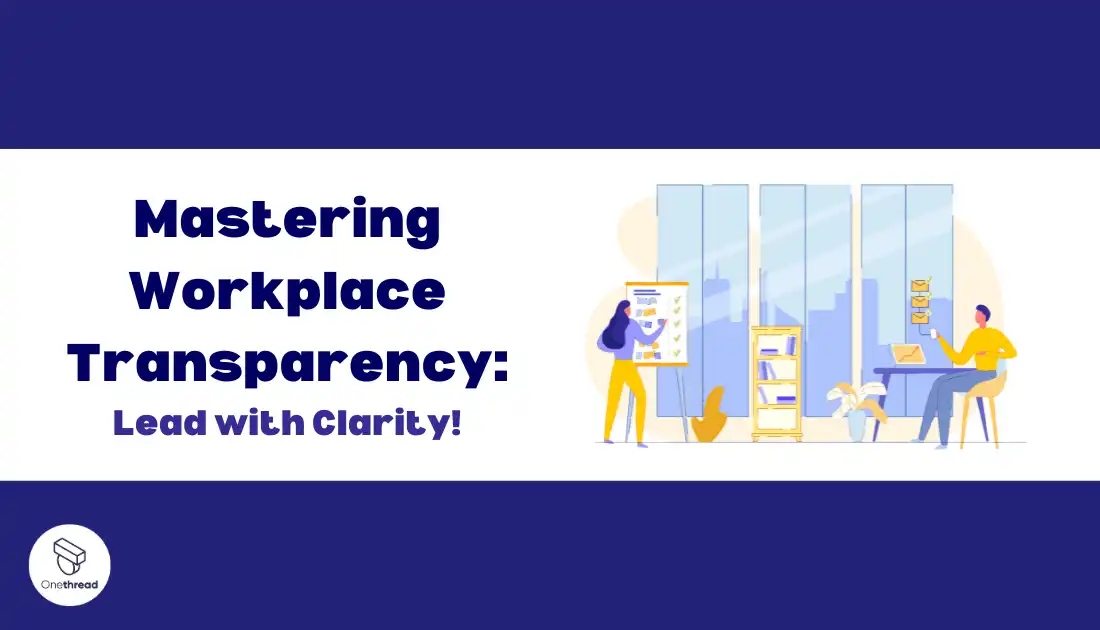Trust and openness are essential for any successful workplace, yet over half of employees report a lack of transparency in their organizations. What exactly is workplace transparency, and why does it matter?
At its core, transparency is about clear and honest communication, participation in decision-making, and accountability at all levels. While there are certainly challenges, research shows transparency leads to higher engagement, performance, and profits.
Building a culture of transparency requires commitment from leadership and an understanding of its true value. This article explores the ins and outs of transparency, providing practical insights to help make your workplace more open.
Let’s dive in to unlock the many benefits transparency can offer.
Key Takeaways:
- Workplace Transparency Boosts Trust: Openly sharing information in the workplace builds trust and makes employees feel valued and involved.
- Transparency Enhances Performance: Clear communication and participation in decision-making lead to higher engagement, efficiency, and profits.
- Leadership Plays a Crucial Role: Transparent leadership sets the tone for an honest, open work environment, encouraging trust and respect at all levels.
- Onethread as a Solution: Onethread supports these transparency goals by providing clear task management, open communication tools, and customizable dashboards, fostering an open and efficient workplace culture.
[INSERT_ELEMENTOR id=”12410″]
What is Workplace Transparency?
Workplace Transparency is when a company openly shares information with its employees. This includes letting them know about company plans, decisions, and any changes happening.
It’s like keeping everyone in the loop so there are no secrets. This openness helps build trust between employees and their bosses. It makes people feel more involved and valued in their jobs. When a company is transparent, everyone understands what’s happening and why.
This can lead to better teamwork and happier employees. It’s like playing a team sport where everyone knows the game plan. Transparency in the workplace creates a positive and honest environment for everyone to work in.
How Does It Affect Workplace Performance And Culture?
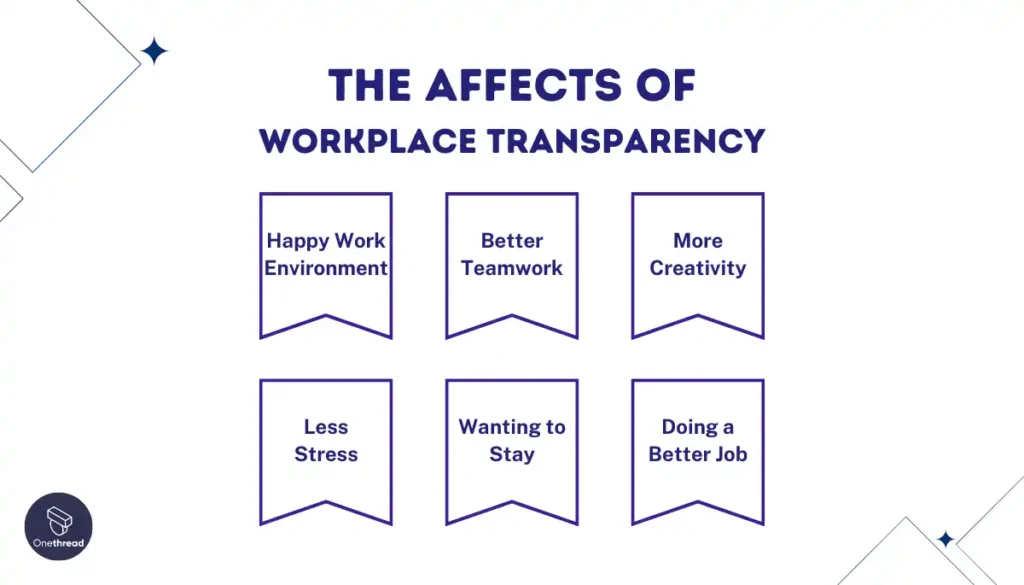
Workplace performance and culture really affect how employees feel and work. A good work environment makes people happy and helps them do their best. Here’s how:
- Happy Work Environment: When the workplace is friendly and supportive, employees feel happier. It’s like being in a classroom where everyone gets along and helps each other.
- Better Teamwork: A good work culture means everyone works well together. It’s like playing on a sports team where every player supports the others.
- More Creativity: When employees are happy, they think of better ideas. It’s like when you feel good, you can be more imaginative and come up with fun games.
- Less Stress: A positive work environment means less worry and stress for everyone. It’s like feeling safe and relaxed in your favorite place.
- Wanting to Stay: Employees who like their work environment usually want to stay at their job longer. It’s like enjoying school so much that you don’t want to miss a day.
- Doing a Better Job: When employees are happy and less stressed, they do their work better. It’s like when you’re happy, you do your homework better and faster.
So, a good work environment is super important. It makes employees feel happy, work well together, be creative, less stressed, want to stay, and do a great job!
Why is Workplace Transparency Important?
Workplace Transparency is really important because it helps everyone at work feel safe and respected. Here’s why it matters:
Protecting Employees:
Workplace transparency is crucial. It allows employees to talk about problems without fear. This includes reporting harassment, discrimination, or crimes at work. Transparency protects employees and improves the workplace.
- Freedom to Speak Up: Employees can talk about problems like harassment or discrimination without being scared of getting in trouble.
- Protection for Employees: When workers can speak freely, it helps stop bad things from happening at work. It keeps everyone safer.
- Makes Workplaces Better: If people can talk about problems, these issues can be fixed. This stops problems from getting worse.
Without it, issues can worsen, creating an unsafe environment. It empowers employees to speak up against wrongdoings.
Workplace Transparency Act
The Workplace Transparency Act is an Illinois law that lets employees report discrimination, harassment, or crimes at work without getting in trouble. It applies to companies with 15+ workers, and even 1 worker starting July 2020. It makes company policies illegal if they stop employees from reporting issues. The law protects workers from retaliation for speaking up.
Who Must Follow Transparency Rules?
According to the Illinois Workplace Transparency Act (WPA), companies with 15 or more employees must follow transparency rules. From July 2020, this includes smaller companies with just one employee. The rules cover regular, part-time employees, unpaid interns, and contractors. Almost all workers are protected.
Exceptions to the Rules:
Unions are a main exception. Unionized workplaces might not follow these rules due to their own contracts. In some cases, like for HR workers or investigators, confidentiality is still required.
Consequences for Non-Compliance:
Companies ignoring these rules face serious risks. Contracts or policies silencing employees can be invalid. Employees can report issues externally. Companies may face fines or lawsuits for violating these laws.
Benefits of Compliance:
Complying with transparency laws is wise. It creates a better work culture and reduces legal risks. Employees feel safe to report injustices, leading to a healthier workplace environment.
Legal Framework:
The Workplace Transparency Act in Illinois (820 ILCS 96) outlines these rules. It aims to prevent discrimination and harassment in the workplace.
The Act applies to various employment contracts and agreements. It ensures that employees can report unlawful practices without restrictions.
Workplace transparency is essential for a safe and fair work environment. It protects employees and holds companies accountable.
Benefits of Workplace Transparency
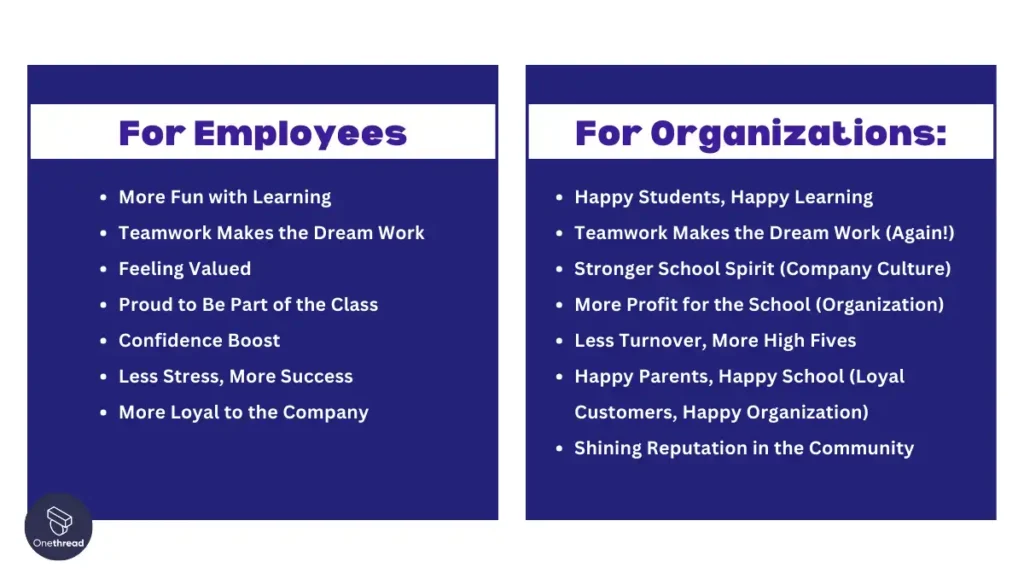
Workplace Transparency is about sharing information openly at work. It’s really important because it benefits both employees and the company.
For Employees:
- More Fun with Learning: When you know the plan and goals, like where you’re headed and why, you feel more connected to your work. It’s like having a clear roadmap, making every task feel like an exciting adventure!
- Teamwork Makes the Dream Work: Transparency encourages open communication and collaboration. You can share ideas, problems, and solutions with your classmates (coworkers), making everyone smarter and more successful.
- Feeling Valued: When you’re kept in the loop and your voice is heard, you feel like an important part of the team. It’s like having a teacher who listens to your suggestions and makes you feel like your contribution matters.
- Proud to Be Part of the Class: Transparent workplaces have strong cultures and values that everyone can be proud of. It’s like having a classroom where everyone feels respected and included, making it a place you love to be in.
- Confidence Boost: Knowing what’s expected and how you’re doing helps you improve and grow. It’s like getting regular feedback on your work, making you feel confident and ready for any challenge.
- Less Stress, More Success: When you’re not guessing or worried about hidden agendas, you can focus on doing your best work. It’s like having a classroom where everyone knows the rules and plays fair, making things run smoothly and stress-free.
- More Loyal to the Company: When you feel valued, respected, and part of something special, you’re more likely to stay and contribute your talents. It’s like having a classroom where everyone feels happy and supported, making you want to come back every day!
For Organizations:
- Happy Students, Happy Learning: Engaged and motivated employees are more productive and do better work. It’s like having a classroom where everyone is excited to learn, making it a fun and successful place to be.
- Teamwork Makes the Dream Work (Again!): When everyone’s collaborating and sharing ideas, innovation skyrockets! It’s like having a classroom where everyone can contribute, leading to creative solutions and amazing results.
- Stronger School Spirit (Company Culture): Transparent workplaces have clear values and goals that everyone understands and supports. It’s like having a classroom where everyone knows the rules and works together to make things awesome.
- More Profit for the School (Organization): Happy, engaged employees who work well together lead to higher productivity and profits. It’s like having a classroom where everyone’s focused on learning and achieving, making the school (company) thrive.
- Less Turnover, More High Fives: When employees feel valued and respected, they’re less likely to leave. It’s like having a classroom where everyone wants to stay and learn, making the school (company) a stable and successful place to be.
- Happy Parents, Happy School (Loyal Customers, Happy Organization): When employees are proud of their work and company, they become brand advocates. It’s like having students who love their school and tell everyone how great it is, attracting more students (customers) and making the school (company) even better.
- Shining Reputation in the Community: Transparent companies are seen as trustworthy and ethical. It’s like having a school with a great reputation, attracting the best students (talent), and making everyone proud to be a part of it.
Workplace Transparency is beneficial because it makes employees happier and helps the company do better.
Potential Drawbacks of Transparency at Workplace
While being open and honest at work is mostly good, it can sometimes have downsides. Here are four disadvantages of transparency:
- Too Much Information Can Overwhelm People: Sometimes, sharing too much information can make employees feel confused or stressed. It’s like when you have too much homework and don’t know where to start.
- Not Everyone Reacts Well to the Truth: Some people might get upset or react badly when they hear something they don’t like. It’s like telling a friend a hard truth, and they get mad.
- Slows Down Decision-Making: When everyone’s opinion is asked for, making decisions can take a long time. It’s like when your whole family tries to pick a movie to watch together.
- Risk of Misinformation: If not done carefully, transparency can lead to sharing wrong or misunderstood information. It’s like playing the telephone game, where the message changes as it goes.
So, while transparency is good, it’s important to do it in the right way.
The Value of Transparency in the Workplace
Let’s see how transparency makes your workplace the coolest place ever:
Transparency is like shining a big, bright light on your workplace. It means being open and honest about things like:
- Goals and plans: Where are we going? What are we trying to achieve?
- Decisions and changes: Why did we make this choice? What does it mean for you?
- Information and data: What’s going on in the company? How are we doing?
And guess what? Transparency makes everything better!
It builds trust: When you’re open and honest, people believe you. They know you’re not hiding anything, so they feel safe and secure. That’s like having a best friend you can tell anything to!
It boosts teamwork and efficiency: When everyone knows the plan, it’s easier to work together and get things done. It’s like having a team of superheroes, each knowing their power and how to use it together!
It attracts the best players: Just like everyone wants to be friends with the honest kid, top talent wants to work for companies that are open and transparent. It’s like being on a winning team, everyone pulling their weight and celebrating together!
It encourages diversity and inclusion: When everyone feels like they have a voice and their ideas are heard, it creates a more welcoming and supportive environment. It’s like having a playground where everyone gets to play, no matter what!
Workplace Transparency Examples
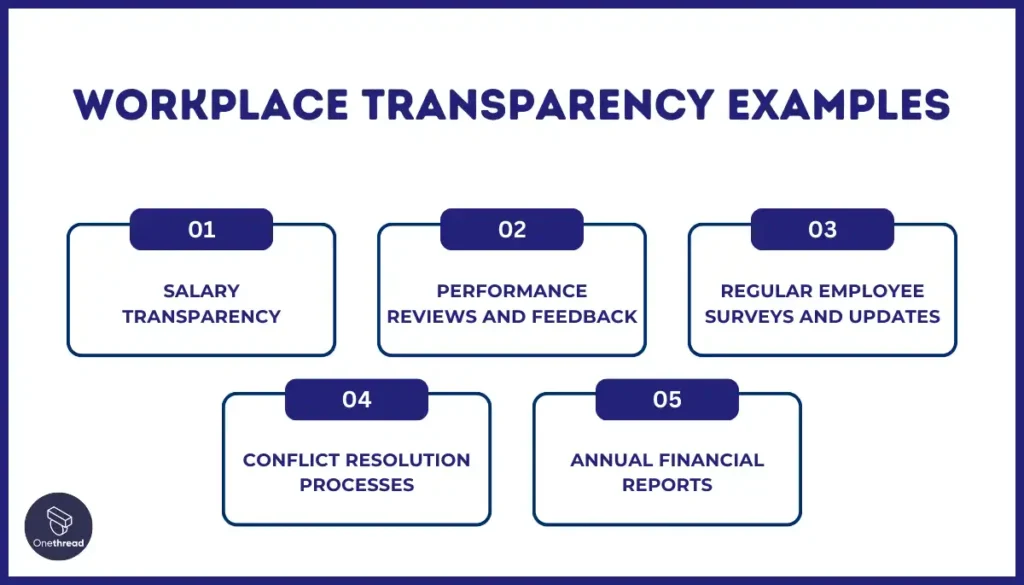
Workplace Transparency means sharing information openly at work. Here are 5 examples of transparency in the workplace:
- Salary Transparency: This is when everyone knows how much everyone else is paid. It helps make sure pay is fair for everyone.
- Performance Reviews and Feedback: This is when bosses tell employees how they’re doing and what they can improve. It helps people learn and grow in their jobs.
- Regular Employee Surveys and Updates: This means asking employees what they think and feel about their work and then sharing the results with everyone. It helps make sure everyone’s voice is heard.
- Conflict Resolution Processes: This is about having clear ways to solve disagreements at work. It helps keep the workplace peaceful and respectful.
- Annual Financial Reports: These are reports that show how the company is doing with its money. Sharing this helps everyone understand the business better.
So, transparency isn’t a scary beast, it’s the secret sauce that makes workplaces awesome! It builds trust, makes everyone feel valued, and helps everyone score A’s in teamwork and happiness!
How To Improve Transparency In The Workplace (Best 9 Ways)
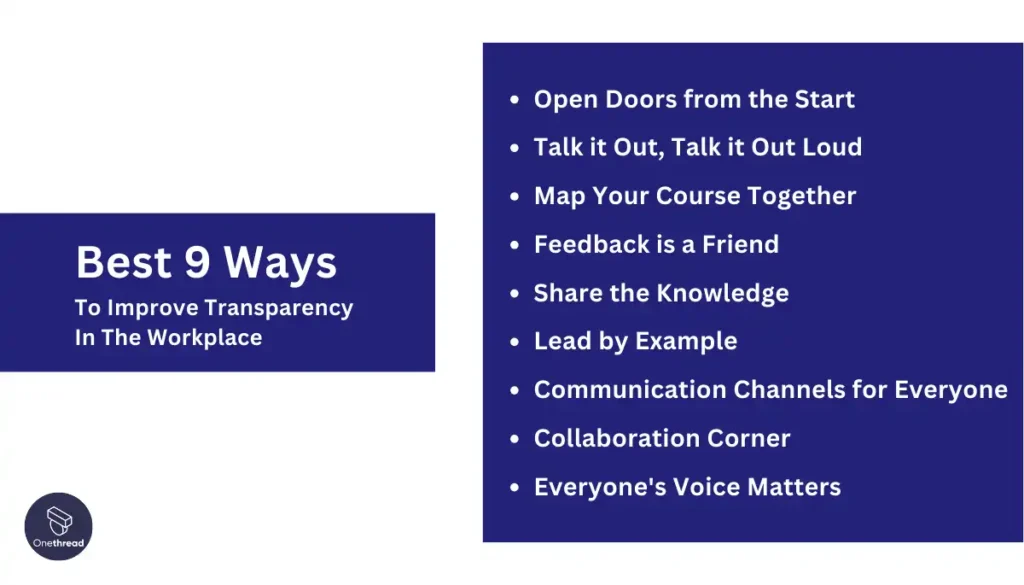
Improving transparency at work means making sure everyone knows what’s happening and feels part of the team. Here are 9 easy ways to shine a light on your workplace and turn it into a transparency haven:
1. Open Doors from the Start:
Right from the interview stage, set clear expectations about your company’s culture and values. Let everyone know what you stand for and how you work together. It’s like giving everyone a clear classroom roadmap before the first day!
2. Talk it Out, Talk it Out Loud:
Communication is key! Hold regular updates, town halls, and Q&A sessions to keep everyone in the loop. Think of it as having fun, open discussions instead of boring lectures!
3. Map Your Course Together:
Give everyone clear goals and expectations, both individually and as a team. Set performance metrics like mini-tests to track progress and make sure everyone’s on the same page. It’s like having a personalized study guide for each student (employee)!
4. Feedback is a Friend:
Encourage feedback and questions! Create open communication channels like suggestion boxes, surveys, or even anonymous reporting systems. Think of it as having a classroom where everyone can raise their hand and ask questions without fear!
5. Share the Knowledge:
Share information readily! Make data and reports accessible to everyone. Encourage knowledge sharing, like having book clubs or peer-to-peer learning sessions. It’s like having a classroom library where everyone can borrow amazing knowledge!
6. Lead by Example:
Leaders should be the ultimate transparency champions! Set an example for openness and honesty. Be approachable, answer questions readily, and admit mistakes. It’s like having a teacher who always plays fair and is always learning alongside you!
7. Communication Channels for Everyone:
Don’t rely on whispers and rumors! Designate clear communication channels, like having classroom representatives who share news with everyone.
8. Collaboration Corner:
Create open spaces where teams can work together, like having group projects in the classroom. Transparency thrives when everyone can brainstorm and share ideas.
9. Everyone’s Voice Matters:
Involve employees in decision-making, like having classroom votes on fun activities. When everyone feels heard, they’re more engaged and invested.
Bonus Transparency Boosters:
- Promote transparency in leadership: Make sure leaders are visible and accessible, and hold them accountable for open communication.
- Make information accessible: Ensure everyone has easy access to relevant data, reports, and company policies.
- Encourage sharing and engagement: Celebrate transparency! Recognize and reward employees who contribute to an open and collaborative culture.
By following these ways, companies can make their workplace more transparent. This helps everyone understand and trust each other more, making work a better place for everyone.
Advanced Perspectives on Transparency
Workplace transparency is like sunshine – it brightens everything up and makes everyone feel happy and productive. But did you know there are different levels and types of transparency, like different shades of sunshine? Let’s explore the hidden rainbows within!
Four Levels of Transparency:
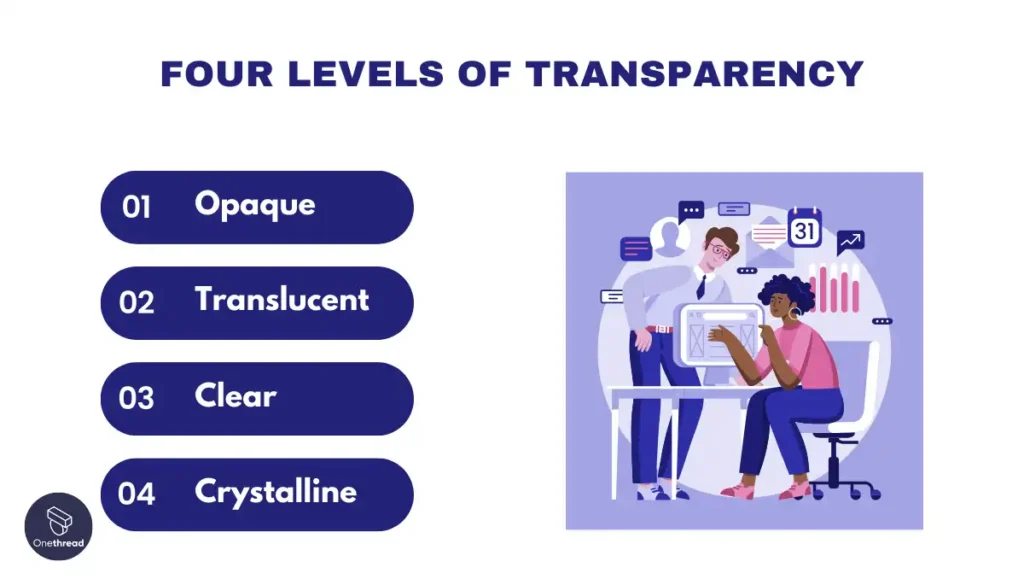
- Opaque: This is like a classroom with blacked-out windows – you can barely see anything! Information is hidden, decisions are made in secret, and everyone feels left in the dark.
- Translucent: It’s like a classroom with frosted glass windows – you can see some blurry shapes, but not the whole picture. Information is shared sometimes, but not always, and some things remain mysterious.
- Clear: This is like a classroom with sparkling clean windows – everyone can see everything! Information is shared openly and regularly, decisions are explained, and everyone feels informed and involved.
- Crystalline: This is like a classroom made of crystal – not only can you see everything, but everything sparkles and shines! Transparency goes beyond information – it’s about trust, open dialogue, and vulnerability.
Three Types of Transparency:
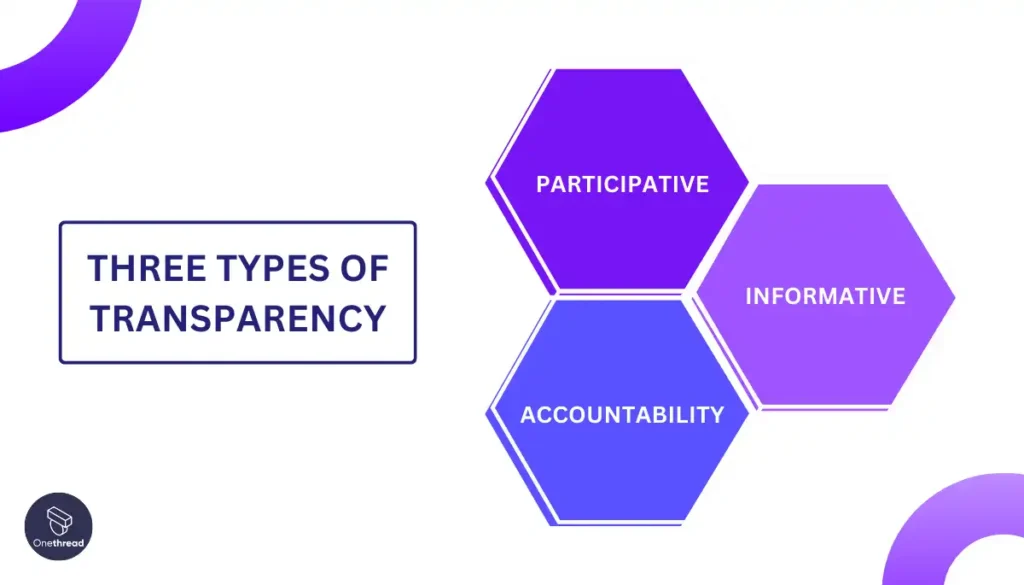
- Participative: This is like a classroom where everyone gets to vote on the lesson plan – everyone is involved in decision-making, and their voices are heard.
- Informative: This is like a classroom where the teacher explains everything clearly and answers all your questions – everyone has access to information and understands what’s going on.
- Accountability: This is like a classroom where everyone takes responsibility for their actions – there are clear rules and expectations, and everyone is held accountable for meeting them.
Key Principles: The Sparkles of Transparency:
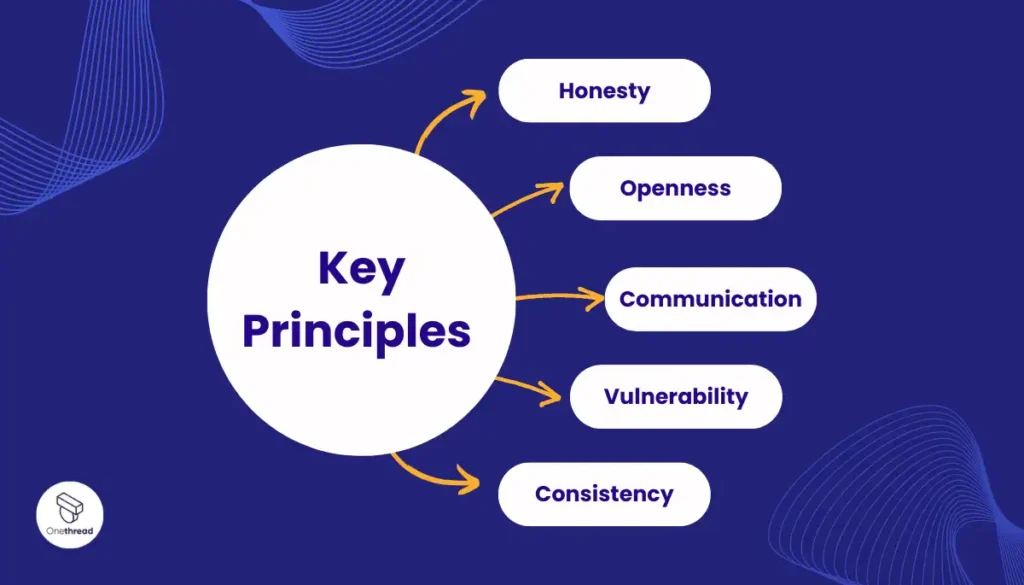
- Honesty: Always telling the truth, even when it’s tough.
- Openness: Sharing information readily and being accessible to everyone.
- Communication: Listening carefully and explaining things clearly.
- Vulnerability: Being open to feedback and admitting mistakes.
- Consistency: Practicing transparency all the time, not just when it’s easy.
With these different levels, types, and principles, you can help create a workplace that’s not just clear, but truly crystalline, a place where everyone feels informed, valued, and ready to shine their brightest!
How to Show Transparency and Trust in the Workplace?
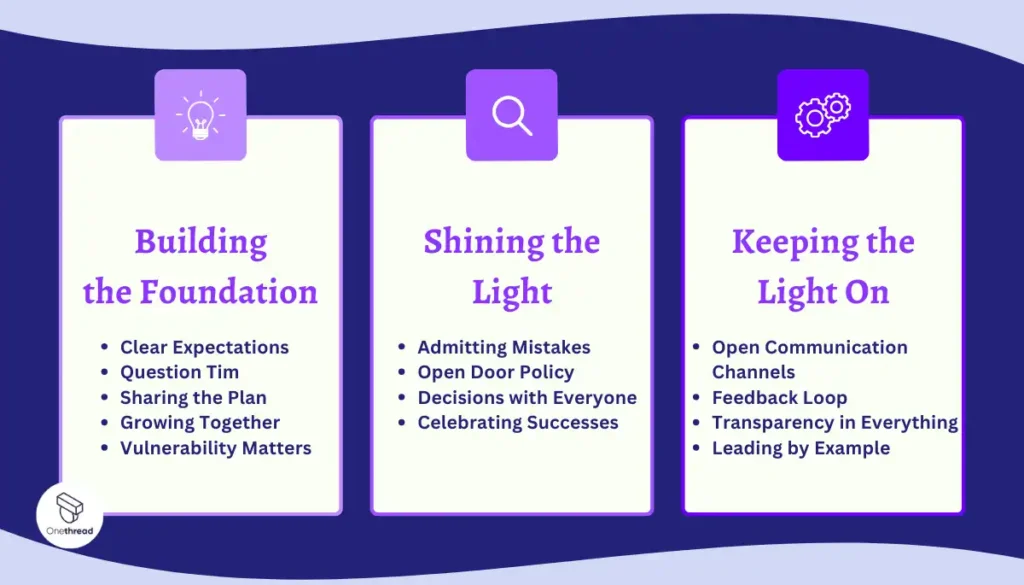
Creating a workplace where everyone trusts each other and shares information openly is important. But how to show or demonstrate transparency in the workplace? Here’s your guide:
Building the Foundation:
- Clear Expectations: Set goals and rules like a teacher with a syllabus. Everyone knows what’s expected and how to achieve it.
- Question Time: Encourage questions and feedback through open discussions in class. Everyone feels heard and valued, leading to better ideas.
- Sharing the Plan: Communicate decisions and business goals like sharing the lesson plan. Everyone understands why things are done and feels involved.
- Growing Together: Offer growth opportunities and feedback like homework help and progress reports. Everyone can learn and improve.
- Vulnerability Matters: Be open about challenges and mistakes like admitting when you don’t know something. It builds trust and shows everyone you’re human.
Shining the Light:
- Admitting Mistakes: Don’t hide problems like a student trying to erase a bad test answer. Acknowledge issues and work together to fix them.
- Open Door Policy: Share company information and metrics like showing your classroom budget. Everyone feels informed and part of the team.
- Decisions with Everyone: Involve employees in decision-making like picking a fun class activity. Everyone feels valued and their voices matter.
- Celebrating Successes: Share team wins and learnings like celebrating a great project. It motivates everyone and strengthens the team spirit.
Keeping the Light On:
- Open Communication Channels: Maintain open communication like having a classroom suggestion box. Everyone can share ideas and concerns.
- Feedback Loops: Continuously gather employee feedback like asking how the class is going. It helps you improve and keep everyone happy.
- Transparency in Everything: Uphold transparency in policies and practices like having clear rules for everyone, not just students.
- Leading by Example: Leaders should be transparency champions like a teacher who follows the rules they set. Show everyone what it means to be open and honest.
By doing these things, companies can build a place where trust and openness are part of everyday work. This makes work a better place for everyone.
Responsibilities Of Employers In The Workplace
Employers have important jobs to do in the workplace to make sure everyone is safe and treated fairly. Here are their main responsibilities:
- Keep the Workplace Safe: Make sure the work area is safe and healthy for everyone.
- Pay Fairly: Give employees the right amount of money for their work.
- Respect the Law: Follow all the laws about treating workers fairly.
- Train Employees: Teach employees how to do their jobs safely and well.
- Listen to Concerns: Hear out employees when they have problems or ideas.
- Provide Equal Opportunities: Make sure everyone has a fair chance, no matter who they are.
- Protect Private Information: Keep employees’ personal details safe and private.
These responsibilities help make sure that work is a good and safe place for everyone.
Leadership and Transparency: Setting the Tone
So, what’s transparency in leadership all about? It’s like having leaders who are open books, they share the plan, explain decisions, and listen to everyone’s ideas. Here are some ways you can do this:
- Share Information Openly: Tell your team about what’s happening in the company.
- Admit Mistakes: It’s okay to say when you’re wrong. This shows you’re honest.
- Listen to the Team: Pay attention to what your team members say and think.
- Make Decisions Together: Include your team in making big choices.
- Be Honest in Communication: Always tell the truth in a kind way.
- Lead by Example: Show how to be transparent in your own actions.
Transparent leadership means being open and honest. Leaders who are transparent share important information with their team. They tell the truth about what’s happening in the company.
This helps everyone trust and respect them more. When leaders are open, it encourages everyone in the company to be open too. It’s like a captain of a sports team who keeps no secrets from their players.
Qualities of a Transparent Leader
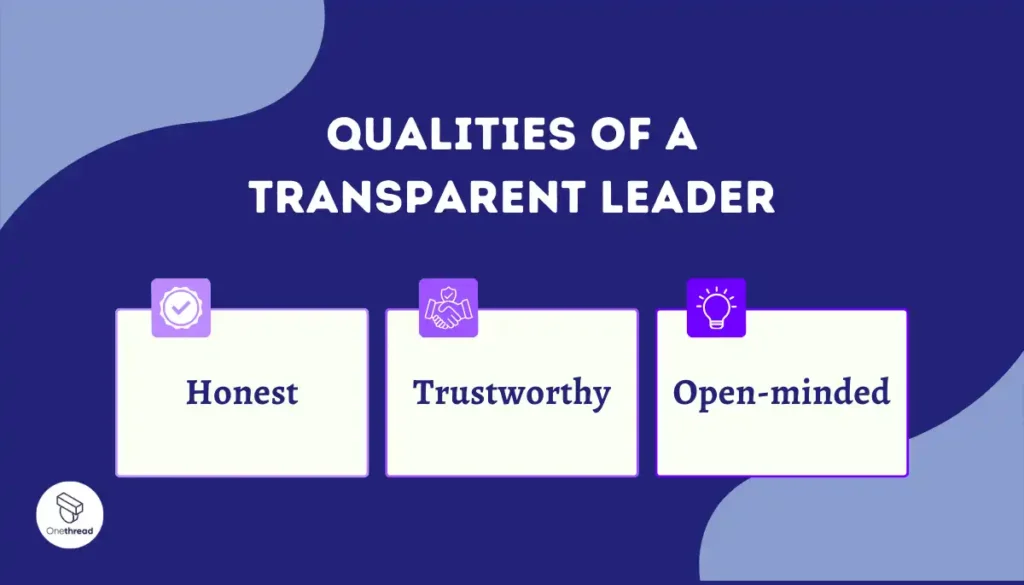
- Honest: The truth is always the best policy, even when it’s tough. Transparent leaders are always honest, even if it means admitting mistakes or sharing bad news.
- Trustworthy: When you know your leader is honest and open, you naturally trust them more. This makes you feel more comfortable taking risks, trying new things, and working hard.
- Open-minded: Transparent leaders aren’t afraid of new ideas, even if they come from someone younger or less experienced. They listen to everyone and are always open to learning new things.
How to Become a More Transparent Leader?
To become a more transparent leader, be open and honest in your communication, share important information with your team, admit your mistakes, and listen to their ideas and feedback. This helps build trust and makes your team feel valued and respected.
How Onethread Can Help You To Become A More Transparent Leader?
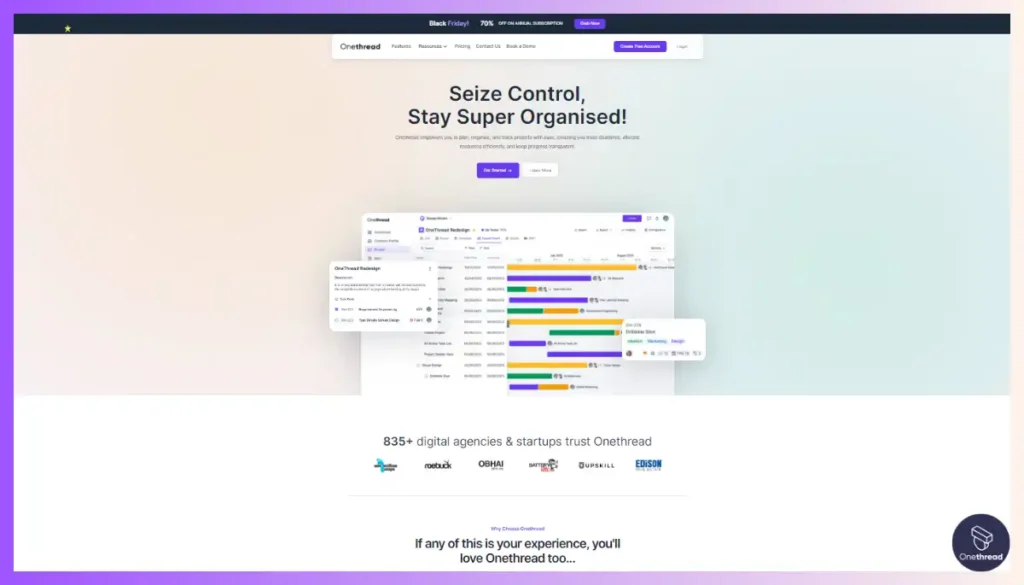
Onethread can be a valuable tool for promoting transparency in your leadership style through several key features and aspects:
Visibility and Openness:
Centralized information:
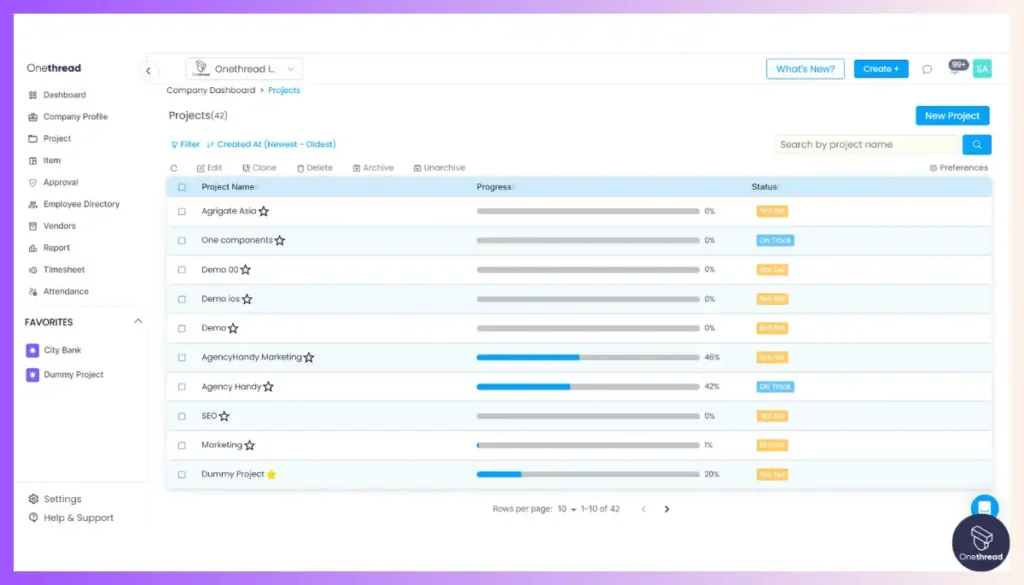
Project information, progress, and discussions are housed in a single platform, readily accessible to team members. This fosters a sense of shared knowledge and reduces information silos.
Task management and progress tracking:
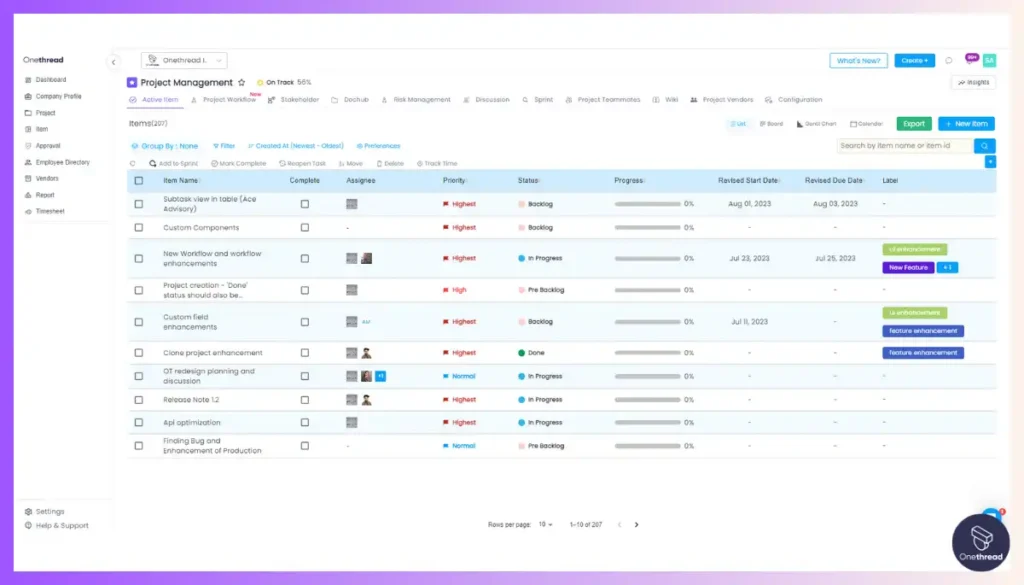
Team members can see assigned tasks, deadlines, and updates, promoting accountability and understanding of individual and team contributions.
Customizable dashboards:
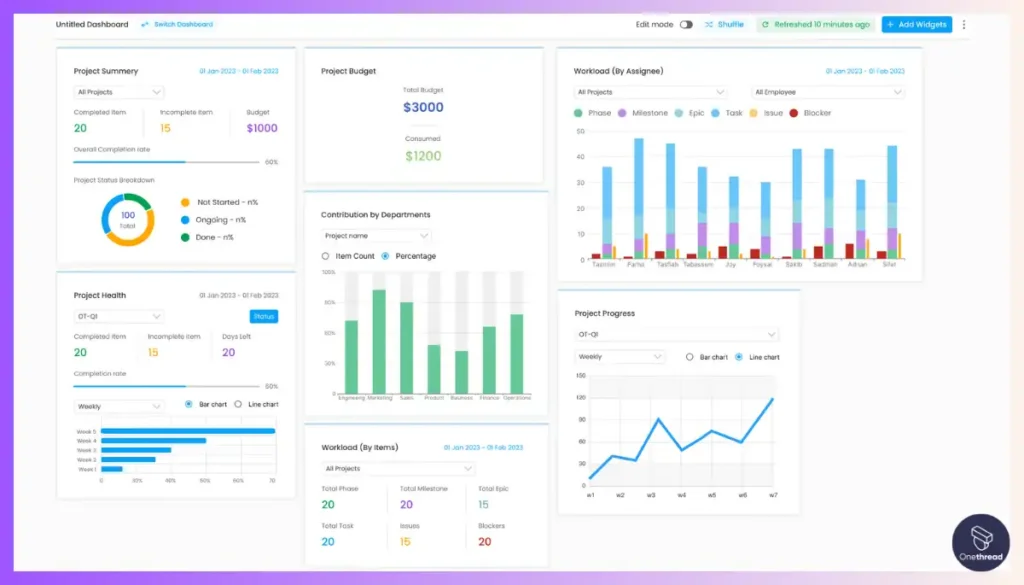
Leaders can create dashboards highlighting key metrics, project health, and individual performance, providing a transparent overview of team progress and goals.
Discussion forum:
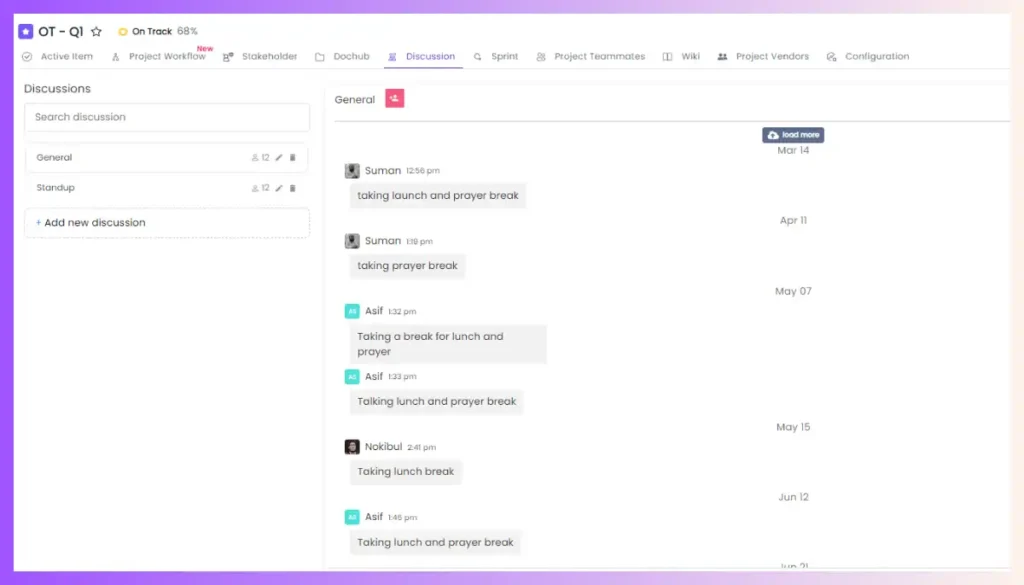
Real-time communication and information sharing through discussions allow for open dialogue, idea exchange, and a better understanding of different perspectives.
Empowerment and Collaboration:
Role-based access control:
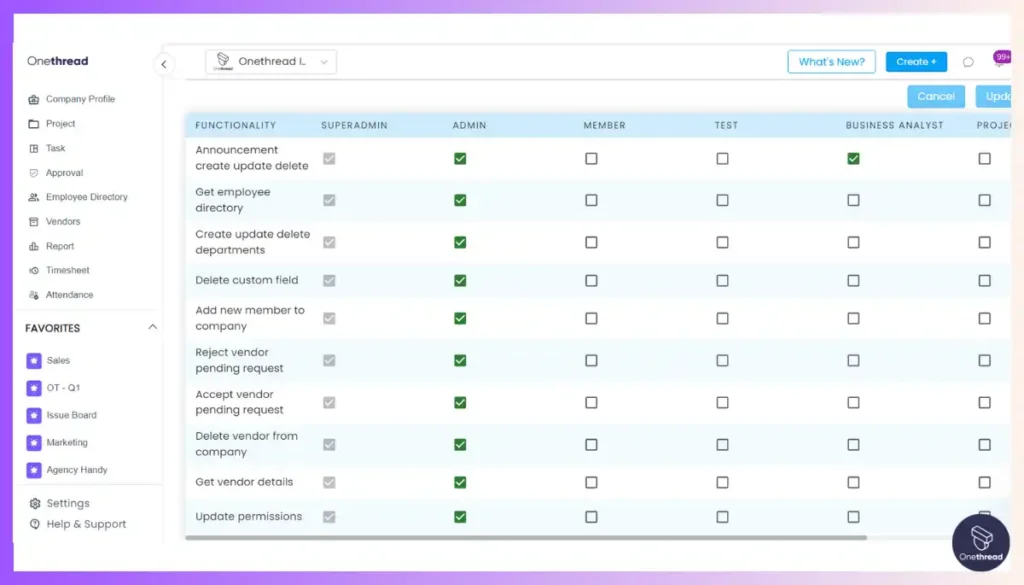
Granting appropriate access levels empowers team members to contribute, make decisions, and take ownership of their roles, fostering trust and transparency.
Customizable workflows:
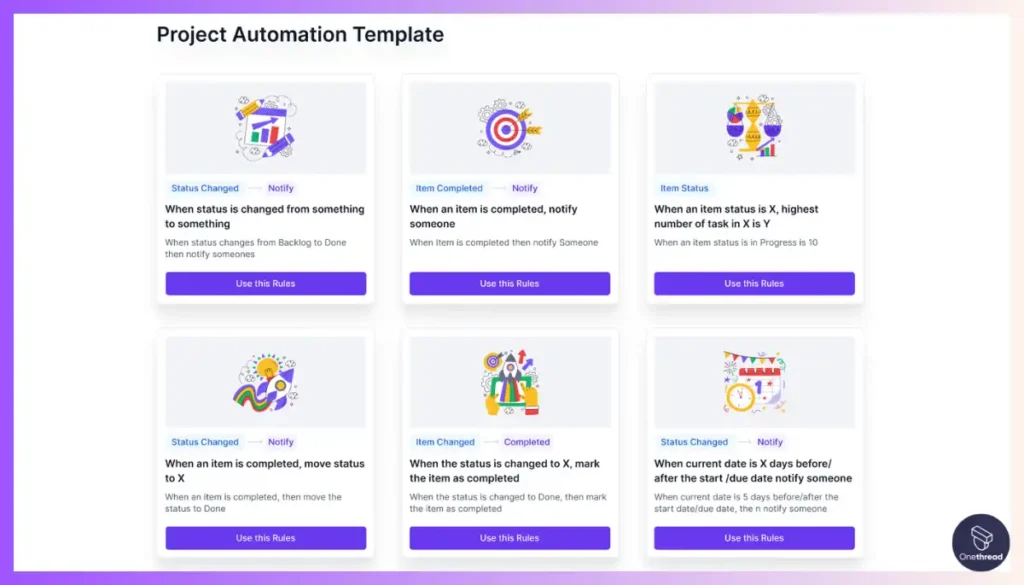
Leaders can design workflows that involve team members in decision-making processes, ensuring everyone feels their voice is heard and contributes to the direction of projects.
Issue management:
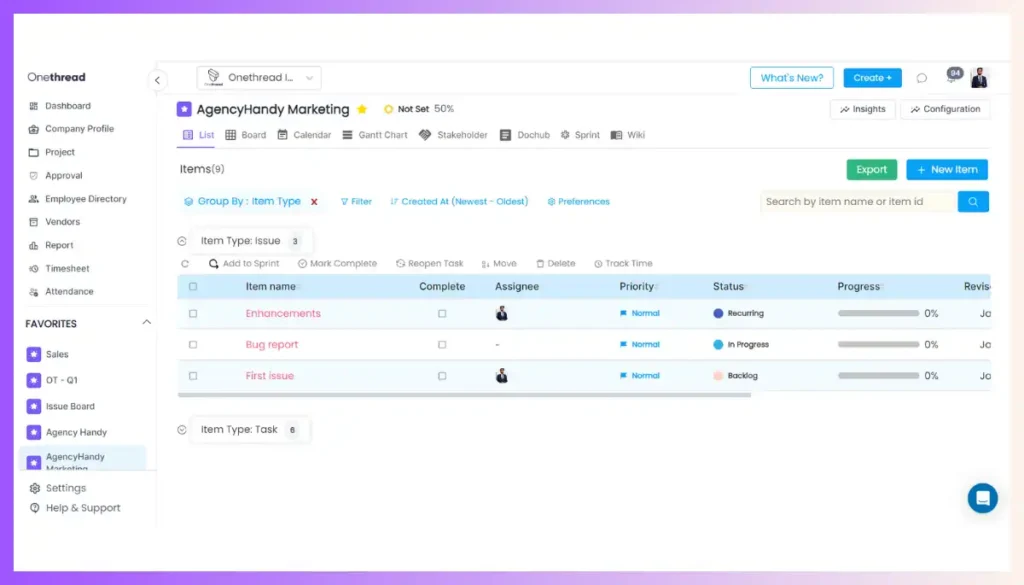
Openly addressing and resolving issues through a dedicated platform encourages team members to raise concerns and participate in finding solutions, building trust, and fostering collaboration.
Data-driven decision-making:
Reporting and analytics:
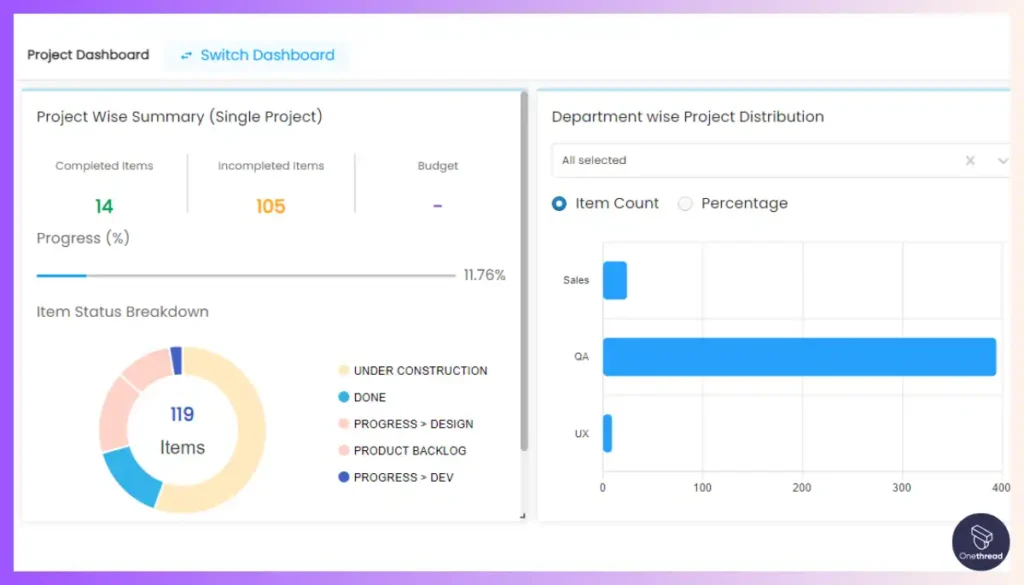
Access to standardized reports and advanced reporting features (in Scale plan) provide data-driven insights into team performance, project progress, and resource allocation. This transparency in data-based decision-making fosters trust and understanding among team members.
Accessibility and Inclusivity:
Simple and user-friendly interface:
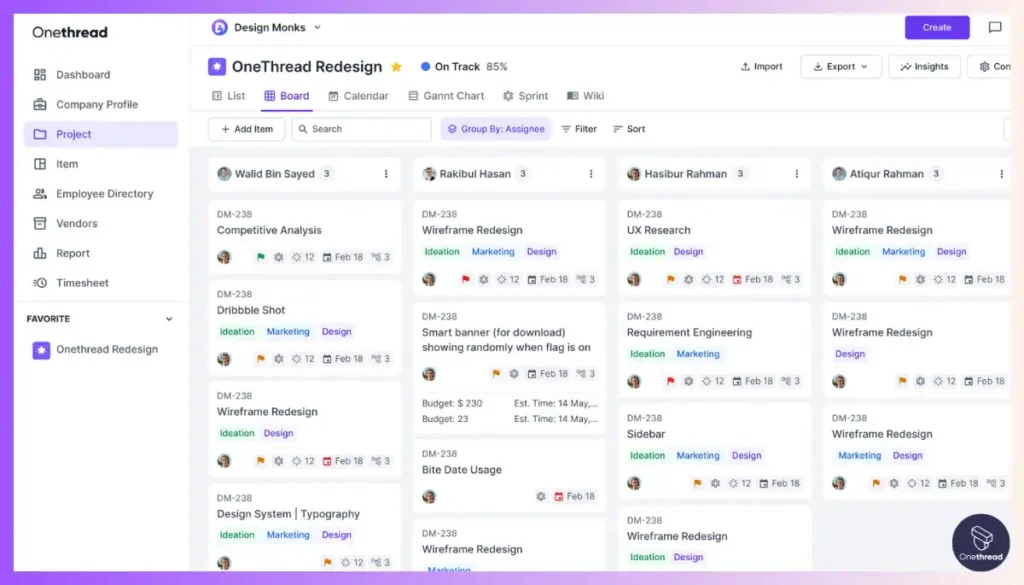
A clean and intuitive platform makes information and tools easily accessible to everyone, regardless of their technical expertise, promoting inclusivity and participation.
Transparency is not just about sharing information; it’s about building trust, fostering collaboration, and empowering your team. Onethread can be a powerful tool for achieving this by providing the platforms and processes to ensure everyone has access to the information they need, feels their voice is heard and is involved in the decision-making process.
[INSERT_ELEMENTOR id=”12410″]
FAQs
What is Transparency in Business Ethics?
Transparency in business ethics means companies share information honestly and openly. It’s about being clear and truthful in how they do business.
What are Transparent Methods?
Transparent methods are ways companies share information clearly. This includes open meetings, honest reports, and straightforward communication.
What are the Types of Corporate Transparency?
Types of corporate transparency include financial disclosure, open communication, and ethical business practices. These show how a company operates honestly.
Which has the Highest Transparency?
Companies with open policies and frequent, clear communication typically have the highest transparency. They share information honestly with everyone.
What are the Core Principles of Transparency?
The core principles of transparency are honesty, openness, regular communication, and accountability. These help build trust and understanding.
Is Transparency Part of CSR?
Yes, transparency is a part of Corporate Social Responsibility (CSR). It’s about being open about a company’s impact on society and the environment.
Is Transparency Part of ESG?
Yes, transparency is part of Environmental, Social, and Governance (ESG) practices. It’s key in showing how companies handle social and environmental issues.
Which Pillar of ESG is Transparency?
Transparency is mainly part of the Governance pillar in ESG. It ensures companies are honest and accountable in their operations and decisions.
Wrap-Up
Workplace transparency is essential for building trust, enhancing performance, and fostering a positive work environment. With tools like Onethread, organizations can effectively implement transparent practices, ensuring clear communication and collaborative success.
Onethread’s features align perfectly with the goals of transparency, making it an invaluable asset in creating an open and honest workplace culture.
[INSERT_ELEMENTOR id=”12410″]
